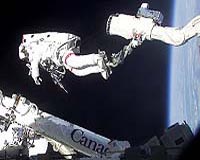 |
Houston TX (SPX) Mar 08, 2010 Boeing has officially turned over the U.S. on-orbit segment of the International Space Station (ISS) to NASA with the signing of government form DD-250 at the conclusion of an Acceptance Review Board meeting in Houston. Often referred to as "handing over the keys," the DD-250 is equivalent to a final bill of sale that formally transfers ownership. Through the review board, NASA and Boeing verified the delivery, assembly, integration and activation of all hardware and software required by contract. "It was 10 years in the making, but NASA's acceptance confirms that the U.S.-built portion of the International Space Station meets its requirements and that its hardware and software are in excellent shape," said Joy Bryant, Boeing ISS vice president and program manager. "The vehicle is capable of being fully utilized as a national laboratory, and we look forward to sustaining it for many years to come." The U.S. segment interfaces with all the ISS international partner elements. It encompasses the truss segments, including the four solar arrays, and several pressurized modules, which consist of:
+ Unity and Harmony, connecting nodes 1 and 2 Additionally, thousands of components make up the segment's core systems for thermal control; environmental control; guidance and navigation; communication and tracking; electrical power distribution; command and control; structure and mechanisms; and robotics. This year, the ISS will mark 10 consecutive years of human presence on orbit. It was designated a national laboratory by the U.S. Congress in 2005 and selected for the 2009 Collier Trophy by the National Aeronautic Association. The station takes advantage of the microgravity conditions 220 miles above the Earth's surface for research across a wide variety of fields, including human life sciences, biological science, human physiology, physical and materials science, and Earth and space science. "Research conducted aboard the ISS will benefit the entire world with unique scientific breakthroughs, and its crews will inspire a new generation to look toward space," said Bryant. Boeing is the prime contractor to NASA for the ISS. In addition to designing and building all the major U.S. elements, Boeing also is responsible for ensuring the successful integration of new hardware and software - including components from international partners - as well as for providing sustaining engineering work.
Share This Article With Planet Earth
Related Links Station at NASA Shuttle at NASA Station at NASA Station and More at Roscosmos S.P. Korolev RSC Energia Watch NASA TV via Space.TV Space Station News at Space-Travel.Com
 Canada to boost space research
Canada to boost space researchOttawa (AFP) March 3, 2010 The Canadian government is to boost its support for research of space technologies, Governor General Michaelle Jean said Wednesday in a speech to open parliament. "Canada has been a space faring nation for 50 years," Jean said in the Speech from the Throne - an address that traditionally opens every session of the Canadian parliament. "Our government will extend support for advanced res ... read more |
|
| The content herein, unless otherwise known to be public domain, are Copyright 1995-2010 - SpaceDaily. AFP and UPI Wire Stories are copyright Agence France-Presse and United Press International. ESA Portal Reports are copyright European Space Agency. All NASA sourced material is public domain. Additional copyrights may apply in whole or part to other bona fide parties. Advertising does not imply endorsement,agreement or approval of any opinions, statements or information provided by SpaceDaily on any Web page published or hosted by SpaceDaily. Privacy Statement |